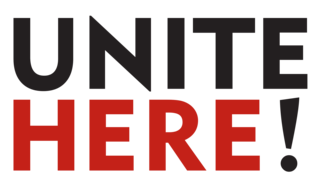
UNITE HERE is a labor union in the United States and Canada with roughly 300,000 active members. The union's members work predominantly in the hotel, food service, laundry, warehouse, and casino gaming industries. The union was formed in 2004 by the merger of Union of Needletrades, Industrial, and Textile Employees (UNITE) and Hotel Employees and Restaurant Employees Union (HERE).

The Bakery, Confectionery, Tobacco Workers and Grain Millers International Union (BCTGM) is a labor union in the United States and Canada primarily representing workers in the food processing industry. The union was established in 1886 as the Journeyman Bakers Union. The contemporary BCTGM was formed in January 1999 as a merger of the Bakery, Confectionery and Tobacco Workers' International Union and the American Federation of Grain Millers.
A comprehensive campaign is labor union organizing or a collective bargaining campaign with a heavy focus on research, the use of community coalition-building, publicity and public pressure, political and regulatory pressure, and economic and legal pressure in addition to traditional organizing tactics.

The California agricultural strikes of 1933 were a series of strikes by mostly Mexican and Filipino agricultural workers throughout the San Joaquin Valley. More than 47,500 workers were involved in the wave of approximately 30 strikes from 1931 to 1941. Twenty-four of the strikes, involving 37,500 union members, were led by the Cannery and Agricultural Workers' Industrial Union (CAWIU). The strikes are grouped together because most of them were organized by the CAWIU. Strike actions began in August among cherry, grape, peach, pear, sugar beet, and tomato workers, and culminated in a number of strikes against cotton growers in the San Joaquin Valley in October. The cotton strikes involved the largest number of workers. Sources vary as to numbers involved in the cotton strikes, with some sources claiming 18,000 workers and others just 12,000 workers, 80% of whom were Mexican.
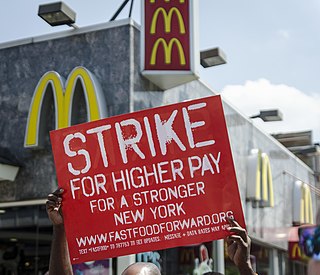
The Fight for $15 is an American political movement advocating for the minimum wage to be raised to USD$15 per hour. The federal minimum wage was last set at $7.25 per hour in 2009. The movement has involved strikes by child care, home healthcare, airport, gas station, convenience store, and fast food workers for increased wages and the right to form a labor union. The "Fight for $15" movement started in 2012, in response to workers' inability to cover their costs on such a low salary, as well as the stressful work conditions of many of the service jobs which pay the minimum wage.
The Harvard Graduate Students Union (HGSU), officially known as Harvard Graduate Students Union United Auto Workers (HGSU-UAW), is a labor union representing graduate students, teaching assistants, and other student employees at Harvard University. The bargaining unit comprises about 5,000 student employees, including graduate students working as research assistants and teaching fellows as well as several hundred undergraduate students holding teaching positions. Contract negotiations with the university are scheduled to begin in Fall 2018. HGSU is affiliated with the United Auto Workers labor union, whose 400,000 members include 45,000 graduate students and 30,000 academic workers.

Strikes occurred during the COVID-19 pandemic due to many factors including: hazard pay or low pay, unsafe working conditions, inability to pay rent. These strikes are separate from the various protests that occurred over responses to the pandemic.

Some warehouse workers of Amazon, the largest American e-commerce retailer with 750,000 employees, have organized for workplace improvements in light of the company's scrutinized labor practices and stance against unions. Worker actions have included work stoppages, and have won concessions including increased pay, safety precautions, and time off. There are unionized Amazon workers in the United States, Italy and Japan with further unionization activity elsewhere in Europe.
The 2021–2022 Columbia University strike was a labor strike involving graduate student workers at Columbia University in New York City. The strike began on March 15, 2021, and ended on May 13, 2021. However, additional strike action commenced on November 3 and lasted until January 7, 2022, when a tentative agreement with the university was reached. The strike was organized by the Graduate Workers of Columbia–United Auto Workers Local 2110 (SWC–UAW), a labor union representing student workers at the university. The goals of the strike were an increase in wages, increased healthcare and childcare coverage, and third-party arbitration in cases of discrimination and sexual harassment.
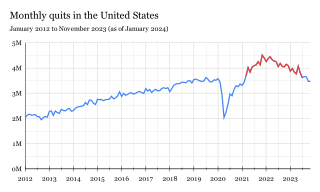
The Great Resignation, also known as the Big Quit and the Great Reshuffle, was a mainly American economic trend in which employees voluntarily resigned from their jobs en masse, beginning in early 2021 during the COVID-19 pandemic. Among the most cited reasons for resigning included wage stagnation amid rising cost of living, limited opportunities for career advancement, hostile work environments, lack of benefits, inflexible remote-work policies, and long-lasting job dissatisfaction. Most likely to quit were workers in hospitality, healthcare, and education. In addition, many of the resigning workers were retiring Baby Boomers, who are one of the largest demographic cohorts in the United States.
The 2021 Frito-Lay strike was a labor strike by employees at the Topeka, Kansas Frito-Lay plant against the company's mandatory overtime policy. The strike began on July 5, 2021 and ended on July 23, 2021.
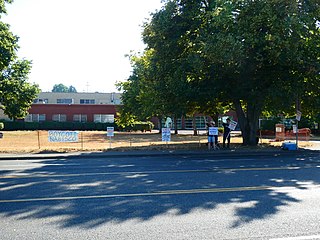
The 2021 Nabisco strike was a labor strike involving workers for the American snack manufacturer Nabisco, a subsidiary of Mondelez International. The strike began at a Nabisco facility in Portland, Oregon on August 10 and over the next few days spread to several more Nabisco facilities throughout the United States.
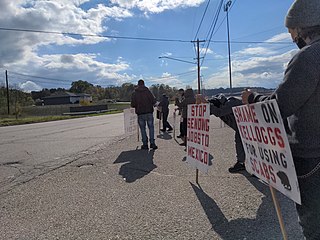
The 2021 Kellogg's strike was a labor strike started on October 5, 2021, and ended December 21, 2021, involving about 1,400 workers for food manufacturer Kellogg's, unionized as members of the Bakery, Confectionery, Tobacco Workers and Grain Millers' International Union (BCTGM). The strike was caused due to disagreements between the union and company concerning the terms of a new labor contract, with particular points of contention concerning the current two-tier wage system, health care, holidays, retirement benefits, cost-of-living adjustments, and vacation time. The strike affected all of Kellogg's cereal-producing plants in the United States, consisting of plants in Battle Creek, Michigan; Omaha, Nebraska; Lancaster, Pennsylvania; and Memphis, Tennessee. It is one of several strikes conducted by the BCTGM in 2021, including strike action against Frito-Lay and Nabisco.
The 2021 Mercy Hospital strike was a labor strike involving nurses and hospital workers at Mercy Hospital of Buffalo, in the United States. The strike began on October 1, 2021, and ended on November 4, 2021. It began following breakdown in collective bargaining negotiations between Communications Workers of America (CWA), the union representing the workers, and the Catholic Health System.

The 2021 John Deere strike was a labor strike in the United States that began on October 14 and ended on November 17, and involved about 10,000 employees for John Deere, a manufacturer of agricultural and heavy machinery. These employees are members of the United Auto Workers (UAW) labor union, which had been negotiating a new contract with John Deere for several months. On November 17, the workers approved a new 6-year contract officially putting an end to the strike. The strike was John Deere's first in over three decades.
The 1986–87 John Deere strike and lockout was a conflict between Deere & Company, more commonly known as John Deere, and its employees. The workers, unionized as part of the United Auto Workers, began selective strikes at three Deere facilities on August 23, 1986. The selective strikes prompted Deere to close the rest of the facilities under the same labor contract as the original three striking locales, which the UAW, and later The New York Times, called a lockout. On February 1, 1987, workers ratified a tentative agreement which provided stronger benefits to Deere production employees. The conflict was the longest strike ever against Deere, lasting 163 days, or more than five months.

The Alliance of Health Care Unions (Alliance) is a union federation of 21 local unions representing roughly 52,000 Kaiser Permanente (KP) employees. The Alliance is one of two union federations that are part of the largest and longest running Labor Management Partnership in the U.S. In 2021, more than 40,000 Alliance members were on the verge of the largest open-ended healthcare strike over concerns of short staffing and a two-tier wage system proposed by KP. On November 13, 2021, the Alliance and KP reached an agreement that preserved leading wages and benefits and defeated the two-tier system.
A number of labour strikes were held throughout 2021.
ABK Workers Alliance is a group of organized workers from video game company Activision Blizzard. Formed in response to a July 2021 state lawsuit against the company for harassment and discriminatory work practices, the worker advocacy group A Better ABK organized walkouts and demonstrations against the company's policy and practices. The quality assurance workers of subsidiary Raven Software went on strike in December after part of the team was fired. The striking workers announced their union as the Game Workers Alliance in late January 2022 and offered to end the strike pending their union's recognition.












